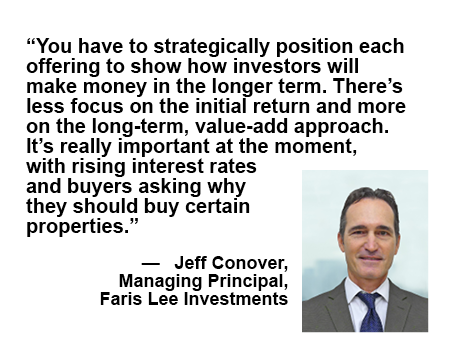
Don MacLellan, managing principal at Faris Lee Investments in Irvine, Calif., knows it’s a challenging market.
“Deal volume is off 40-60 percent from two years ago,” he says. “Back then, there was so much deal momentum because demand was so much higher than supply. Now, it’s the opposite, and due to lower transaction volume, 1031 demand is off significantly. So, the question becomes, how do you create strong demand with fewer 1031 exchange requirements?”
It’s a question MacLellan and his fellow Faris Lee managing principals Jeff Conover and Shaun Riley have been looking to solve.

On face value, the goal is to recreate the stronger investor demand of 2021-2022. In actuality, the realistic goal is to bridge the price gap between today’s sellers and buyers. That means sellers may have to compromise on price or other concessions, while buyers may need to accept lower cash/cash returns to obtain a quality asset.
Selling Points
There are many factors that determine whether a retail real estate investment is attractive or not. How large a consideration any one factor is may depend on the type of buyer and their objectives … or it may depend on the market.
“Strategic discussions with sellers really delve into pricing nowadays,” Conover says. “Pricing is critical at the moment. Your price needs to be a shinier lure than the pricing on similar product in the market because there’s such a lack of buyers right now.”
Another way to make that lure shine is by emphasizing the quality of the real estate, which includes upside opportunities, as well as its location. Faris Lee recently executed this strategy on the sale of a single-tenant net leased investment property in Farmington, N.M., that is currently occupied by JOANN Fabrics and Crafts.
“JOANN had just filed for bankruptcy a week or two before the deal closed,” Conover adds. “But this was a high-return buyer who was willing to take on the risk. The real estate was the driver that got this deal closed.”
The craft and fabric retailer still has 11 years remaining on the 20,000-square-foot, free-standing pad building. It is situated within a center that boasts Home Depot, TJ Maxx, Safeway and Best Buy as anchors, which further enhanced the property’s value proposition.
“This asset was well under market,” MacLellan notes. “If JOANN does vacate, there is a strong potential to backfill this space with another tenant at a higher rent.”
Highlighting an asset’s value proposition and upside potential are almost as important as pricing in this market, Riley adds.
“You have to strategically position each offering to show how investors will make money in the longer term,” he explains. “There’s less focus on the initial return and more on the long-term, value-add approach. It’s really important at the moment, with rising interest rates and buyers asking why they should buy certain properties.”
If motivated pricing, the value proposition and upside potential fail to move the asset, a seller’s next move may be to consider carrying the note or paying additional points for a lower interest rate.
“In the $10-, $15- and $20-million range, we’re exploring if sellers can carry back paper in the near term,” MacLellan says. “We’re doing short-term, two- to three-year seller carry to get through this increasing interest rate environment. The idea is, two years down the road, rates will be lower.”
He notes this strategy is not for everyone, as some sellers require 1031 exchanges, but adds it has produced success for some. MacLellan also points out that the 10 Year Treasury has continued to increase over the past 60-90 days. This, naturally, has negatively impacted investors’ pricing.
“It takes a little education, but paying for additional points on a loan can artificially lower the interest rate,” MacLellan continues. “The seller may have to spend $100,000 to do so, but it can save the deal and oftentimes get them their listing price, which could be worth a $300,000 to $400,000 swing, so it can be worth it.”
Buying It
Sellers may be challenged with offloading properties, but today’s potential buyers face obstacles as well. Namely, buyers are concerned with locking in long-term interest rates as they are concerned that rates may be less in 2025 and 2026.
“A lot of debt funds have become active because they are typically two-to-three-year terms,” MacLellan says. “Credit unions are also becoming more popular because there’s no pre-payment penalty, which offers flexibility to refinance in a couple of years when rates are expected to be lower.”
In terms of opportunities for buyers, Conover likes the tax-free states and Sunbelt.
“We’re looking in Georgia down to Florida,” he says. “They’re also coming around on Tennessee and Texas. You can take on risk but get rewarded in the tertiary markets.”
Riley adds that smaller, multi-tenant products ranging from 4,000 to 12,000 square feet are also favorable with today’s buyers. That’s because this type of asset poses lower risk if a vacancy occurs. He notes that multi-tenant retail has been particularly popular with owner-users as of late. One reason? The financing.
“They can come in and occupy not necessarily the traditional 51 percent that’s associated with Small Business Administration (SBA) financing because other lender platforms for owner-users have become attractive,” Riley explains. “They can obtain better financing than investors will and can then purchase triple-net leased shopping center investments where they occupy one to two suites. We’ve seen a lot of demand and a lot of success with this.”
Of course, there is still the possibility from time to time that a deal will be too good to pass up for one reason or another. That was the case recently with the undisclosed buyer of a fully occupied mixed-use property on Balboa Island in Newport Beach, Calif.
The two separate parcels, located at 325-331 Marine Ave., feature storefront retail with two second-floor residential units. Faris Lee and SSG Realty Corp. executed the sale, which saw the asset trade for $4.4 million, or $1,193 per square foot for the building and $842 per square foot for the land.
“This was a unique property on Marine Avenue,” Conover says. “It has a high barrier to entry from an investment standpoint, as not many properties trade there.”
The cap rate was 2.88 percent, but Conover notes that wasn’t the buyer’s priority in the deal.
“It was a low return and high cost per foot, but it didn’t matter because it was a trophy asset for the high-net-worth, private family office,” he continues. “It was a generational-type investment.”
— By Nellie Day. This post is posted as part of Shopping Center Business’ Retail Insight series. Click here to subscribe to the Retail Insight newsletter, a four-part newsletter series, followed by video interviews delivered to your inbox in May/June.


